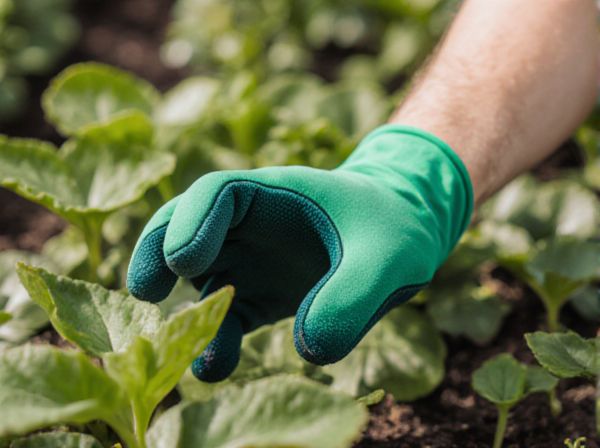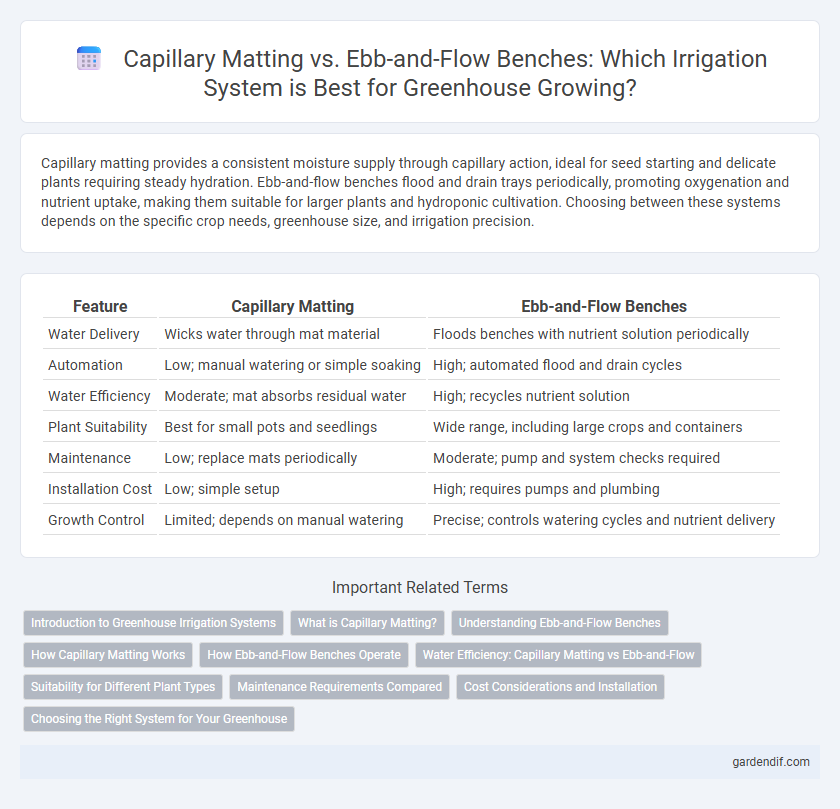
Capillary Matting vs Ebb-and-Flow Benches Illustration
Capillary matting provides a consistent moisture supply through capillary action, ideal for seed starting and delicate plants requiring steady hydration. Ebb-and-flow benches flood and drain trays periodically, promoting oxygenation and nutrient uptake, making them suitable for larger plants and hydroponic cultivation. Choosing between these systems depends on the specific crop needs, greenhouse size, and irrigation precision.
Table of Comparison
| Feature | Capillary Matting | Ebb-and-Flow Benches |
|---|---|---|
| Water Delivery | Wicks water through mat material | Floods benches with nutrient solution periodically |
| Automation | Low; manual watering or simple soaking | High; automated flood and drain cycles |
| Water Efficiency | Moderate; mat absorbs residual water | High; recycles nutrient solution |
| Plant Suitability | Best for small pots and seedlings | Wide range, including large crops and containers |
| Maintenance | Low; replace mats periodically | Moderate; pump and system checks required |
| Installation Cost | Low; simple setup | High; requires pumps and plumbing |
| Growth Control | Limited; depends on manual watering | Precise; controls watering cycles and nutrient delivery |
Introduction to Greenhouse Irrigation Systems
Capillary matting and ebb-and-flow benches are two efficient greenhouse irrigation systems designed to optimize water usage and promote healthy plant growth. Capillary matting delivers water through a porous fabric that uniformly wicks moisture to plant roots, ideal for smaller containers and tray setups. Ebb-and-flow benches operate by flooding and draining water in a controlled cycle, supporting larger propagation trays and enhancing oxygen availability to roots for robust germination and growth.
What is Capillary Matting?
Capillary matting is a water distribution system used in greenhouses that provides consistent moisture to plants through capillary action, eliminating the need for traditional flooding techniques. Made of absorbent materials such as felt or synthetic fibers, capillary mats evenly spread water across the surface, allowing plant roots to draw up moisture as needed. This method conserves water and reduces disease risks compared to ebb-and-flow benches, which periodically flood and drain the bench surface.
Understanding Ebb-and-Flow Benches
Ebb-and-flow benches in greenhouses utilize a flood and drain watering system that promotes efficient nutrient absorption by periodically flooding the root zone and then draining excess water. This technique maintains optimal moisture levels, prevents root rot, and enhances oxygen availability compared to capillary matting, which relies on passive water distribution through capillary action. Understanding the automated irrigation cycles and customizable flooding frequency of ebb-and-flow benches is crucial for optimizing plant growth and resource use.
How Capillary Matting Works
Capillary matting in greenhouses operates through passive watering by utilizing the natural capillary action of water moving from a reservoir below up into the mat surface, providing consistent moisture directly to plant roots. This system ensures uniform water distribution, reducing the risk of overwatering and improving water efficiency compared to ebb-and-flow benches that flood and drain periodically. Capillary mats also encourage healthier root development by maintaining optimal moisture levels and aeration.
How Ebb-and-Flow Benches Operate
Ebb-and-flow benches operate by flooding the bench's growing tray with nutrient-rich water, allowing plants to absorb moisture through their roots before draining the excess back into a reservoir. This cyclical watering system ensures optimal oxygen levels in the root zone, promoting healthy growth and preventing waterlogging. The timing and frequency of the flooding can be precisely controlled to meet the specific needs of different crops within the greenhouse environment.
Water Efficiency: Capillary Matting vs Ebb-and-Flow
Capillary matting delivers superior water efficiency by providing a consistent, even moisture supply directly to plant roots through capillary action, minimizing evaporation and runoff. Ebb-and-flow benches use periodic flooding and draining, which can result in higher water consumption due to excess water loss and uneven distribution. Capillary matting optimizes water use in greenhouse environments, reducing waste and supporting sustainable horticulture practices.
Suitability for Different Plant Types
Capillary matting provides consistent moisture ideal for small seedlings, herbs, and moisture-loving plants, promoting uniform root hydration without overwatering. Ebb-and-flow benches suit larger or drought-tolerant plants requiring periodic flooding and draining, encouraging aerobic root environments and preventing waterlogging. Selecting between these systems depends on plant water needs, root structure, and growth stage to optimize health and yield.
Maintenance Requirements Compared
Capillary matting requires minimal maintenance, involving periodic cleaning to prevent algae buildup and occasional replacement of worn sections, making it ideal for low-maintenance greenhouse setups. Ebb-and-flow benches demand more intensive upkeep, including regular inspection and cleaning of pumps, plumbing, and reservoir tanks to avoid clogs and ensure efficient water recirculation. The maintenance frequency and complexity are higher with ebb-and-flow systems due to mechanical components and susceptibility to nutrient solution contamination.
Cost Considerations and Installation
Capillary matting offers a cost-effective irrigation solution with lower initial setup expenses and simpler installation compared to ebb-and-flow benches. Ebb-and-flow benches require a more complex plumbing system and higher upfront investment but provide precise water control and reduced labor costs over time. Selecting between the two depends on budget constraints, greenhouse size, and long-term operational priorities.
Choosing the Right System for Your Greenhouse
Capillary matting offers consistent, energy-efficient watering by delivering moisture directly to plant roots, reducing water waste and promoting healthy growth in greenhouse environments. Ebb-and-flow benches provide flexibility with periodic inundation, allowing for precise nutrient control and suitability for various plant types requiring different water cycles. Selecting the right system depends on plant water needs, bench space, and automation capabilities to maximize greenhouse productivity and sustainability.
Capillary Matting vs Ebb-and-Flow Benches Infographic

 gardendif.com
gardendif.com